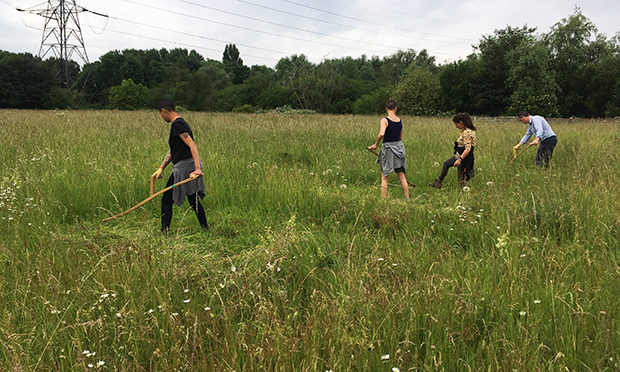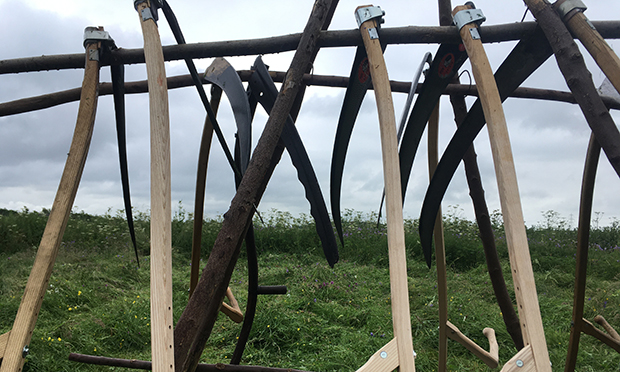The Citizen Gardener: Scythe in pleasure

It seems nobody can talk about scything without mentioning the grim reaper or Poldark. They seldom mention tai qi or anteaters.
The Royal Horticultural Society (RHS), in its prediction of trends for 2022, cites scything as likely to increase in popularity because it’s great for the environment – and brilliant for yer central core (they didn’t say that actually, I added it because it is fantastic exercise).
A flurry of articles in the press recently all brought up those cliches and suggested how hard it is. It isn’t. I know because it’s become another of my new obsessions and last year I joined the Scything Association of Britain and Ireland – or SABI – which (similar to the Worm Society I wrote about recently) is a surprisingly new organisation. It celebrated its first decade in 2021.
Scything has many benefits over petrol or electric mowers. There are no emissions of course; they don’t cost anything to run and there is little maintenance. The lack of sound (or just the gentle swish of a long blade in grass) is important for wildlife.
My trainer at Emorsgate Seeds, Richard Brown, told us that he’d recently taught gardeners from London Zoo as the anteaters were self-harming because of the noise of the strimmers used to cut the grass. I don’t imagine they are the only animals that get upset by the screaming of modern mowers.
Scything is good for cutting round obstacles (like trees) as you can get right up to the trunk without damage so scything is often used in orchards and churchyards. You are less likely to mangle any wildlife, too, with your blade, as insects, amphibians and small mammals have time to escape the cutter.
Yet another peril for hedgehogs is the strimmer (along with loss of habitat and cars). Petrol or electric-powered mowers kill frogs and toads as well.
When I learned to scythe we began with a tai qi move which involves rocking from foot to foot. This is the rhythm and action you keep to when cutting. There is a gentle twist from your waist as you move your arms in a semi-circle in front of you. You’re not hacking but sliding the super-sharp blade over the grass. There are some mesmerising videos on YouTube worth looking at. One’s been viewed over 21 million times!
‘Just five minutes of scything puts me in an excellent mood’
There is something immensely soothing and cheering at the same time with this repeated action. Just five minutes of scything puts me in an excellent mood and I long to get back to it when I’ve stopped. It can be tiring but you have to stop every few minutes to sharpen your blade. This is a bit of a chore but once you get the hang of it, is quite quick and gives you a rest.
It has, incidentally, also given me the confidence to sharpen all sorts of other tools. (If you’ve got any rusting secateurs, I’m happy to restore them.)
Although I am a beginner, I’ve found scything (or mowing as it is known amongst the scything community) to be a very efficient way of cutting grass (and anything else in your way; a scythe can get through brambles and nettles easily).
Some people use a scythe to cut their lawns as you can get the blade as low, if not lower, than a powered strimmer or mower. You can also cut long grass and wet grass, which isn’t possible with a modern mower.
One of the reasons why people keep their lawns continuously short is that modern mowers can’t cope with long grass so they have to go over it every week to keep it short enough to cut. This means that the lawn becomes very neat but sterile and lifeless. What can possibly exist in grass that’s an inch long?

Simon Fairlie, in his book Managing Grass in Britain with a Scythe, says that the scyther can “sit in a deck chair and watch the grass grow as long as he or she fancies… For a month or two the lawn can be allowed to burgeon into a lush meadow, dotted with flowers and busy with insects, until gradually its verdure begins to tire and one dewy morning the scyther, in one swoop, brings it back to the status of lowly turf”. And there’s little that’s more satisfying.
As with most things, though, cutting grass is neither all or nothing and depends on what you want to achieve. If you want a variety of plant species and habitat for insects, in a meadowy way it needs to be allowed to complete its life cycle (flower and produce seed) but then cut to keep it healthy, allow space for those creatures and plants that need short grass and open space and to create space for seeds to drop. It’s important to remove the cuttings as if you leave them on they will rot and make your grass too fertile and make competition too vigorous for most wild flowers, which like low nutrient soil.
SABI say that “grass or meadow left uncut through to autumn can suffer losses of quality and diversity. Taller more dominant plants have more time to grow unchecked, smothering out low growing and less competitive herbs and grasses”.
In short, according to Plantlife: “Cutting too much or too early or too late can lead to a loss of species, but too little cutting, or worse not cutting at all, will allow thug plants and too much scrub to dominate.”
They recommend cutting twice a year – once at the end of flowering and then in the winter (bit.ly/3sIm33r). If you are confused go for a Mowhican – that is, part long and part short. You can cut paths and patterns through long grass.
There are quite a few scythers in the area. I started by learning at the Waterworks off Lea Bridge Road with Ida Fabrizio and I recently did a refresher course at the Company Drinks garden in Barking Park where they cut their grass with scythes (companydrinks.info).
‘What can possibly exist in grass that’s an inch long?’
There used to be an annual scything day on Hackney Marshes which I hope we can revive. I’m also available if anyone wants any grass cut. (Note, Parks Dept: I’m happy to come and scythe for you! For nothing. That’s how much I like it!)
Where to learn: Look up SABI for courses at scytheassociation.org.
Where to buy: thescytheshop.co.uk and scythecymru.co.uk.
I’ve picked out some other predictions from the RHS list of 52 – many of which I’ve written about in the last year so nice to see them catching up!
- More of a focus on growing plants that can survive drought and flood, saving water and long-term resilience of plants (see their campaign, mains2rains.uk).
- Increased awareness and care for soil health not just because of its capacity to store carbon, but because healthy soil is fundamental to all we do in the garden. Reduced digging, increased plant coverage and using locally-produced compost.
- Ethically and sustainably-grown house plants.
- Sharing more of our space with nature. – More ponds, less plastic, less use of pesticides, more reusing and recycling. Greater awareness and commitment to improving biodiversity.
- More small-scale, community and guerrilla gardening.
- Greater awareness from health and social care professionals of the positive benefits plants have on our mental, physical and social health.
- Food-growing will continue to be important as people are more aware of food miles and the problems with the food chain. I’m involved in three new community gardens starting next year so there’s definitely a surge in interest.
- Support for British or home-grown cut flowers. It’s easier to buy more sustainable flowers through Flowers from the Farm, which connects consumers with locally-grown flowers (flowersfromthefarm.co.uk). But there’s also a move towards growing your own cut flowers so there will be more nurseries and seed-growers promoting plants for cutting.
- The renaissance of the cottage garden. The feature of cottage gardens is their diversity and also a loose, ‘hands-off’ gardening attitude.
- Hedges not walls: Hedges are often better for the environment providing habitat and food for a range of animals; but they are also good for security. Growing spiny plants like blackthorn can really put an intruder off!
- Increase in organic and ethical growing – and going peat-free.
- Crazy paving is coming back!
Kate is an award-winning community gardener. She was chosen to be the UK’s first ever postcode gardener in E5 as part of Friends of the Earth’s 10xGreener project. For more information, head to cordwainersgrow.org.uk and friendsoftheearth.uk.
